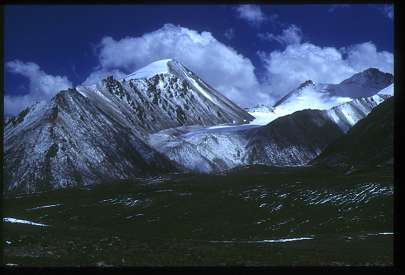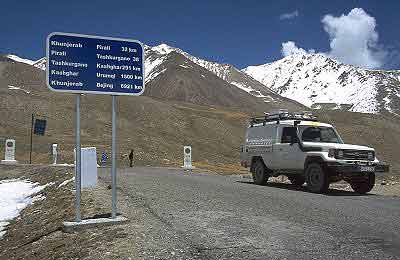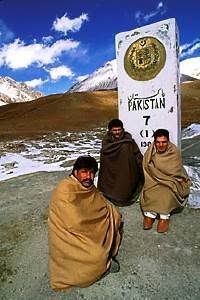Being at Khunjerab Pass is a unique experience for those who like the mountains. On the way up on Kharakorum Highway (KKH), there are innumerable options right from simple sight seeing to hard adventure, or a mix of both. Khunjerab surpasses them all. It is one of the world’s highest passes connecting two countries, and mountains on either side.
In summer, a stream of buses from down country, motorcycles and bickers (through China) reach Khunjerab. KKH has become one of the world famous routs for bikers and motorcyclists. At times the pass seems like a place where international cultural diffusion takes place.
Travellers are seen clicking the shutters of their cameras standing around milestone situated at the pass for memory sack or exchanging addresses and promises to send the photographs to each other. From this place one is 400 kilometres away from Kashgar and 880 kilometres from Islamabad. Those who are not acclimatized, experience a degree of altitude sickness, headaches, and or drowsiness as well. And in winters, it is lonely out there.
Beyond Pirali, the place on KKH before the snows of Khunjerab make existence difficult, the first impression of Khunjerab Pass at 15072 feet above sea level is a long series of switchbacks around the pass. The immediate sight on home side alone is worth the trip to the pass. On either side, massive angular mountains crowd the horizon – silent guards of some highest peaks on planet — celestial giants thrusting toward the heavens. Snow-capped pinnacles pierce through white misty clouds amidst kaleidoscopic purple dusks.
The sharp jagged peaks of the Karakorums on ours side distinguish a region of former feudal princedoms, valley kingdoms and states some call Little Tibet. The region is home to more tall mountains than Nepal and Tibet combined together. This is “the Roof of the World,” where four greatest mountain ranges in the world come together – the Himalaya, Pamirs, Karakorums and Hindu Kush. The landscape on the Chinese side is noticeably smoother. There are mountains — the snow-clad rounded Pamirs to the east — but the valley is more open. Yaks, sheep, camels, and people can be seen from the last point, and everything seems different even at a distance.
 I have very romantic memories of sitting at lonely places (don’t call me loner), enjoying physical beauty and being taken by my own thoughts and perceptions of the places I happened to be at. One pleasure in travelling alone is that no one is around to remind about others waiting for you to start back! Alone at Khunjerab, climbing up a gorge, I was treated to the rare sight of Markhor sheep (well, I think I saw one). So artfully had nature blended them with the terrain that it becomes hard to tell where the rocks or Markhor stands? With the air thinning I continued climbing, hairpin after hairpin till I began to see the straight road that spans beyond Sost – Pakistan custom and immigration post. This is another matchless experience. Looking up to and walking on mountains, at Khunjerab one see them almost at eye level. I sat at the gorge for a while and saw so much unappreciated beauty. BTW, This is one place where Salageet (Shilajit) comes from?
I have very romantic memories of sitting at lonely places (don’t call me loner), enjoying physical beauty and being taken by my own thoughts and perceptions of the places I happened to be at. One pleasure in travelling alone is that no one is around to remind about others waiting for you to start back! Alone at Khunjerab, climbing up a gorge, I was treated to the rare sight of Markhor sheep (well, I think I saw one). So artfully had nature blended them with the terrain that it becomes hard to tell where the rocks or Markhor stands? With the air thinning I continued climbing, hairpin after hairpin till I began to see the straight road that spans beyond Sost – Pakistan custom and immigration post. This is another matchless experience. Looking up to and walking on mountains, at Khunjerab one see them almost at eye level. I sat at the gorge for a while and saw so much unappreciated beauty. BTW, This is one place where Salageet (Shilajit) comes from?
Caravans as far back as the fourth century have been using this historic pass. Ivory, spices, silk and jade were hauled through Rocky River gorges and grassy valleys. This was where Marco Polo trekked through taking news of a legendary kingdom back to Europe. Along this giant oriental trading autobahn, intrepid explorers bartered goods, exchanged ideas and discovered technologies. A steady trickle of horseback commerce crossed the Khunjerab until the 1950s. Up above the road, remnants of old mule tracks from the old days are still evident, etched along mountainsides.
After the completion of KKH, the Khunjerab Pass was opened to traffic and trade in 1982, and to tourists in 1986. Khunjerab in local language means valley of blood, a reference to local bandits who used to take advantage of the difficult terrain to plunder caravans in ancient days. Now it is safe and one can buy much sought after “Do Ghore ki Boski” at many places in the way.
 Any travellers can have all this and more using a bus service or better still a four wheel driven topless jeep on KKH. Khunjerab is also a starting point for more adventurous who want to explore the catchments of Sukhtar Abad commonly known as the Blue Sheep Valley — a little known habitat of Blue sheep, the Himalayan ibex and possibly snow leopards. Due to lack of tracks, Sukhtar Abad is not easily accessible. It can be approached from three different routes, Nazim Abad village through Dikarjerb crossing — a high altitude pass, Hussain Abad village through Gourdour Pass; and from the Khunjerab River, when it is relatively dry in winters. Those who have visited the valley say it is very rewarding but takes some serious trekking to reach the valley.
Any travellers can have all this and more using a bus service or better still a four wheel driven topless jeep on KKH. Khunjerab is also a starting point for more adventurous who want to explore the catchments of Sukhtar Abad commonly known as the Blue Sheep Valley — a little known habitat of Blue sheep, the Himalayan ibex and possibly snow leopards. Due to lack of tracks, Sukhtar Abad is not easily accessible. It can be approached from three different routes, Nazim Abad village through Dikarjerb crossing — a high altitude pass, Hussain Abad village through Gourdour Pass; and from the Khunjerab River, when it is relatively dry in winters. Those who have visited the valley say it is very rewarding but takes some serious trekking to reach the valley.
The Khunjerab grasslands came under the control of rulers of Hunza in the late 18th century. They used to allocate grazing rights to villagers, and in turn used to receive from them a tax in the form of livestock and livestock products. Hunza rulers controlled hunting in the area as well as any trans-border trade with China. Their own livestock grazed in the Khunjerab pastures, tended by designated shepherds, who sent livestock and the products when ordered to Baltit Palace, Hunza. The situation changed when the princely states were merged into Pakistan in the early 70s. Area in Gilgit district, comprises of 2,269 square kilometres, either side of the KKH from Dih to Khunjerab Pass as Khunjerab National Park.
Khunjerab Pass has become increasingly accessible now. The construction of KKH and air service to Gilgit has resulted in an increase in the number of visitors, both foreign and domestic. With increase in access, the mountain pastures, valleys, and wildlife habitats, previously valued for centuries as grasslands and woodlands, have now become the objects of desire of a number of competing interests — resort hotels, adventure tourism, big game hunting, mountaineering, and conservation organizations, to name a few. Each group is interested in maximizing its return from usage of the resources in the area. Khunjrab is losing its serenity in the process.
S A J Shirazi is a Lahore (Pakistan) based writer. His blog is called Light Within, where a version of this post first appeared.




















































https://t.me/s/Official_1win_kanal?before=1603
b9q2tu
Официальный Telegram канал 1win Casinо. Казинo и ставки от 1вин. Фриспины, актуальное зеркало официального сайта 1 win. Регистрируйся в ван вин, соверши вход в один вин, получай бонус используя промокод и начните играть на реальные деньги.
https://t.me/s/Official_1win_kanal/2691
https://t.me/s/Official_1win_kanal/935